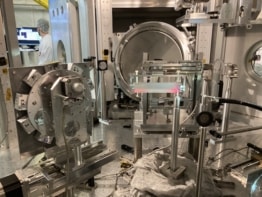Physicists in France have made the first direct measurement of the Boltzmann constant by laser spectroscopy. The new technique, which involves observing how light is absorbed by ammonia molecules, is currently much less accurate than existing methods for measuring the constant. However, the researchers are confident that its accuracy could easily be improved and that the technique could help to create a new and improved definition of the kelvin unit of temperature (Phys. Rev. Lett. 98 250801).
The Boltzmann constant, kB, is a fundamental constant of nature that relates the kinetic energy of an ensemble of microscopic particles — such as gas molecules — to its temperature. As a result, it provides the crucial link between the microscopic world of atoms and molecules and the macroscopic properties of matter such as pressure. So far, there is only one technique — measuring the speed of sound in argon gas – that can determine kB to an accuracy of about 2 parts-per-million (ppm). Other techniques for determining kB include measuring noise in a resistor; determining the dielectric constant of a gas; and measuring the radiation emitted from a black body. However, none of these techniques has yet to reach ppm accuracy.
Having a number of independent measurements of kB – those based on techniques that are subject to different systematic errors – at the ppm level is particularly important to the Paris-based International Committee for Weights and Measures (CIPM), which is planning to redefine the kelvin in 2011 using kB.
The kelvin is currently defined as 1/273.16 of the temperature difference between absolute zero and the triple point of very pure water held at a certain pressure. While the triple point technique can define the kelvin to better than 1 ppm, the problem with this definition is that it is based on a specific physical situation, which must be reproduced whenever a highly accurate definition of the kelvin is required. The CIPM, however, wants to define the kelvin and other SI units in terms of each other and the fundamental constants. In the case of the kelvin, this involves the second and kB — and therefore an accurate value of the kelvin could be obtained from the second, which is known to an extremely high degree of accuracy of about one part in 1016.
Now, Christian Chardonnet and collegues at Université Paris 13 – Institut Galilée, claim to have developed a laser spectroscopy technique that could provide an alternative way of measuring kB to ppm accuracy. The technique exploits the fact that the thermal motion of a molecule – ammonia in Chardonnet’s experiment — smears out peaks in its optical absorption spectrum in a process called thermal broadening. The width of the broadening is determined by kB as well as the pressure and temperature of the gas and the frequency of the light being absorbed. By measuring the width of the broadening as a function of pressure at a fixed temperature and frequency, Chardonnet and colleagues were able to determine kB to an accuracy of about of about two parts in ten thousand.
Although this is nowhere near the accuracy needed by the CIPM, the researchers believe that, in principle, the technique could be improved to 1 ppm. Specifically, the team intend to use more stringent temperature control in their experiment in order to stabilize the temperature to better than 1 ppm. They also intend to increase the amount of ammonia in the path of the laser and improve the stability of the laser, which should allow more data to be accumulated in a shorter time.



